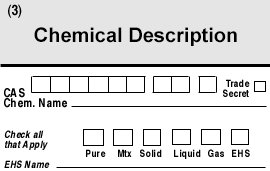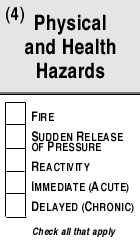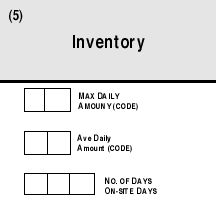WHAT IS A TIER TWO REPORT??
What the whole form looks like

 The Tier Two form, when filled out correctly, provides much more information
than just the Tier One. It provides the same information as a Tier One
report, but also requires the chemical storage locations. It (Section 2a)
names the facility and provides its address. The owner or operator's name,
phone, and mailing address is also required (Section 2b). It has the names
and 24-hour contact information for the emergency contacts at a facility
(Section 2c).
The Tier Two form, when filled out correctly, provides much more information
than just the Tier One. It provides the same information as a Tier One
report, but also requires the chemical storage locations. It (Section 2a)
names the facility and provides its address. The owner or operator's name,
phone, and mailing address is also required (Section 2b). It has the names
and 24-hour contact information for the emergency contacts at a facility
(Section 2c).  The year for which the report is filed is in Section 2d. (Some
of the information on the Tier Two report can be declared unavailable to the
public, like the locations of chemicals at the facility, and the contact
names and telephone numbers. But the firefighters, the LEPC, and the SERC
must be provided this information.)
The Tier Two form also has the
information about the SIC code and the Dun and Bradstreet number in Section
2a. The SIC, Standard Industrial Classification code, tells about what
types of business a facility is engaged in. This is already being replaced
by NAICS code, which is based on the same concept, only more precise.
The year for which the report is filed is in Section 2d. (Some
of the information on the Tier Two report can be declared unavailable to the
public, like the locations of chemicals at the facility, and the contact
names and telephone numbers. But the firefighters, the LEPC, and the SERC
must be provided this information.)
The Tier Two form also has the
information about the SIC code and the Dun and Bradstreet number in Section
2a. The SIC, Standard Industrial Classification code, tells about what
types of business a facility is engaged in. This is already being replaced
by NAICS code, which is based on the same concept, only more precise.
 The
Dun and Bradstreet Number is useful in determining whether the facility is a
stand-alone entity or part of another corporation or company. This Dun and
Bradstreet Number can also be useful in determining who or what would be
liable in the event of a catastrophic release of chemicals. Another use is
to determine if the company has a history of environmental problems or
superior environmental performance at other locations.
The
Dun and Bradstreet Number is useful in determining whether the facility is a
stand-alone entity or part of another corporation or company. This Dun and
Bradstreet Number can also be useful in determining who or what would be
liable in the event of a catastrophic release of chemicals. Another use is
to determine if the company has a history of environmental problems or
superior environmental performance at other locations.
The Tier Two form, in Section 3, requests the CAS Chem name, which is the
Chemical Abstract Service(CAS) registry number. Many chemicals have
different names, and the CAS standardizes things for easier reference. To
obtain a list of EPA regulated chemicals and the laws that apply call
1-(800) 424-9346 and ask for a free copy of the "List of Lists." A chemical
listed on a Tier Two report could be the pure chemical, or a watered down
version. It could be a mixture that includes the chemical. It could be a
mixture of several chemicals. An MSDS for a chemical mixture can show the
chemical mixture has several chemical ingredients. One of these boxes, Pure
or Mix, on the Tier Two form will always be checked for each chemical.
The Tier Two form will list whether the chemical is a solid, liquid, or gas.
 One of these will always be checked for each chemical.
One of these will always be checked for each chemical.
The Tier Two form will list whether the chemical is an Extremely Hazardous
Substance (EHS).
 The Tier Two form, in Section 4, will show what type of physical or health
hazard the chemical presents. Immediate (acute) health hazard includes
"highly toxic," "toxic," irritant," "sensitizer," "corrosive," and other
hazardous chemicals that cause an adverse effect to a target organ (lungs,
kidney, liver, skin) which usually occurs rapidly as a result of short term
exposure. Delayed (chronic) health hazard includes "carcinogens" and other
hazardous chemicals that cause an adverse health effect to a target organ
and the effects of which occur as a result of long term exposure and are of
long duration.
The Tier Two form, in Section 4, will show what type of physical or health
hazard the chemical presents. Immediate (acute) health hazard includes
"highly toxic," "toxic," irritant," "sensitizer," "corrosive," and other
hazardous chemicals that cause an adverse effect to a target organ (lungs,
kidney, liver, skin) which usually occurs rapidly as a result of short term
exposure. Delayed (chronic) health hazard includes "carcinogens" and other
hazardous chemicals that cause an adverse health effect to a target organ
and the effects of which occur as a result of long term exposure and are of
long duration.
It will also show whether it is a fire hazard. Fire hazard includes
"flammable," "combustible liquid," "pyrophoric," and "oxidizer.
It will show if the chemical is in a pressurized tank that could explode or
burst and send shrapnel everywhere--sudden release of pressure hazard.
Sudden release of pressure hazard includes "explosive" and "compressed gas."
It will show if the chemical will combine with other chemicals (including
water) and create heat, explosion or other new chemicals.--reactivity
hazard? Reactive hazard includes "unstable reactive," "organic peroxide,"
and "water reactive."
 The Tier Two form will show how much of the chemical is the maximum amount
on site under Section 5. It will also show the average amount on site. It
will show the number of days the chemical was present at the facility during
the calendar year. Some states require facilities to report the actual
amount, but the federal Tier Two form allows reporting by code. The higher
the number, the higher the amount a chemical can range. An easy way to
interpret the range is to think of the number shown as the number of zeros
possible. For example, a range value of 2 is 100-999 pounds. Similarly, a
range value of three would be 1,000 (three zeros) to 9,999.
The Tier Two form will show how much of the chemical is the maximum amount
on site under Section 5. It will also show the average amount on site. It
will show the number of days the chemical was present at the facility during
the calendar year. Some states require facilities to report the actual
amount, but the federal Tier Two form allows reporting by code. The higher
the number, the higher the amount a chemical can range. An easy way to
interpret the range is to think of the number shown as the number of zeros
possible. For example, a range value of 2 is 100-999 pounds. Similarly, a
range value of three would be 1,000 (three zeros) to 9,999.
The amount of a chemical on-site relates to whether there can be an off-site
consequence of a spill.
A brief description of the storage locations should be printed onto the Tier
Two report. The idea is that the emergency responders will be able to locate
the area easily. It is an option to attach a site plan or diagram. There may
be more than one location. Emergency responders do not like surprises, so
it is best to have the information complete. Though not a requirement, it is
also best if the facility invites in the fire department to review its
emergency plan so both the facility and the fire department understand what
each others needs are going to be in an emergency situation. This is most
effective when done prior to an emergency incident.
The location of chemicals stored at a facility may be withheld from the
public, but not from the fire department, the LEPC, and the SERC. A facility
may have this held confidential by writing "Confidential" on the
Non-Confidential Location section of the Tier Two form.

 The Tier Two form, when filled out correctly, provides much more information
than just the Tier One. It provides the same information as a Tier One
report, but also requires the chemical storage locations. It (Section 2a)
names the facility and provides its address. The owner or operator's name,
phone, and mailing address is also required (Section 2b). It has the names
and 24-hour contact information for the emergency contacts at a facility
(Section 2c).
The Tier Two form, when filled out correctly, provides much more information
than just the Tier One. It provides the same information as a Tier One
report, but also requires the chemical storage locations. It (Section 2a)
names the facility and provides its address. The owner or operator's name,
phone, and mailing address is also required (Section 2b). It has the names
and 24-hour contact information for the emergency contacts at a facility
(Section 2c).  The year for which the report is filed is in Section 2d. (Some
of the information on the Tier Two report can be declared unavailable to the
public, like the locations of chemicals at the facility, and the contact
names and telephone numbers. But the firefighters, the LEPC, and the SERC
must be provided this information.)
The Tier Two form also has the
information about the SIC code and the Dun and Bradstreet number in Section
2a. The SIC, Standard Industrial Classification code, tells about what
types of business a facility is engaged in. This is already being replaced
by NAICS code, which is based on the same concept, only more precise.
The year for which the report is filed is in Section 2d. (Some
of the information on the Tier Two report can be declared unavailable to the
public, like the locations of chemicals at the facility, and the contact
names and telephone numbers. But the firefighters, the LEPC, and the SERC
must be provided this information.)
The Tier Two form also has the
information about the SIC code and the Dun and Bradstreet number in Section
2a. The SIC, Standard Industrial Classification code, tells about what
types of business a facility is engaged in. This is already being replaced
by NAICS code, which is based on the same concept, only more precise.
 One of these will always be checked for each chemical.
One of these will always be checked for each chemical.
 The Tier Two form, in Section 4, will show what type of physical or health
hazard the chemical presents. Immediate (acute) health hazard includes
"highly toxic," "toxic," irritant," "sensitizer," "corrosive," and other
hazardous chemicals that cause an adverse effect to a target organ (lungs,
kidney, liver, skin) which usually occurs rapidly as a result of short term
exposure. Delayed (chronic) health hazard includes "carcinogens" and other
hazardous chemicals that cause an adverse health effect to a target organ
and the effects of which occur as a result of long term exposure and are of
long duration.
The Tier Two form, in Section 4, will show what type of physical or health
hazard the chemical presents. Immediate (acute) health hazard includes
"highly toxic," "toxic," irritant," "sensitizer," "corrosive," and other
hazardous chemicals that cause an adverse effect to a target organ (lungs,
kidney, liver, skin) which usually occurs rapidly as a result of short term
exposure. Delayed (chronic) health hazard includes "carcinogens" and other
hazardous chemicals that cause an adverse health effect to a target organ
and the effects of which occur as a result of long term exposure and are of
long duration.
 The Tier Two form will show how much of the chemical is the maximum amount
on site under Section 5. It will also show the average amount on site. It
will show the number of days the chemical was present at the facility during
the calendar year. Some states require facilities to report the actual
amount, but the federal Tier Two form allows reporting by code. The higher
the number, the higher the amount a chemical can range. An easy way to
interpret the range is to think of the number shown as the number of zeros
possible. For example, a range value of 2 is 100-999 pounds. Similarly, a
range value of three would be 1,000 (three zeros) to 9,999.
The Tier Two form will show how much of the chemical is the maximum amount
on site under Section 5. It will also show the average amount on site. It
will show the number of days the chemical was present at the facility during
the calendar year. Some states require facilities to report the actual
amount, but the federal Tier Two form allows reporting by code. The higher
the number, the higher the amount a chemical can range. An easy way to
interpret the range is to think of the number shown as the number of zeros
possible. For example, a range value of 2 is 100-999 pounds. Similarly, a
range value of three would be 1,000 (three zeros) to 9,999.
 The Tier Two form also has places to be filled out for the type of container
or containers the chemical is in, whether it is under pressure, and the
temperature it is maintained at, if any. This is found at Section 6 of the
Tier Two Report. The same chemical could be stored at several places around
the facility, and in several types of containers. Examples of containers
include: above ground tank, below ground tank, tank inside building, steel
drum, plastic or non-metallic drum, can, carboy, silo, fiber drum, bag, box,
cylinder, glass bottles or jugs, plastic bottles or jugs, tote bin, tank
wagon, and a rail car. The chemical could be at more or less pressure than
the outside (ambient) air. It could be kept at warmer than ambient, or less
than ambient temperatures. It could be kept at super cold (cryogenic)
temperatures.
The Tier Two form also has places to be filled out for the type of container
or containers the chemical is in, whether it is under pressure, and the
temperature it is maintained at, if any. This is found at Section 6 of the
Tier Two Report. The same chemical could be stored at several places around
the facility, and in several types of containers. Examples of containers
include: above ground tank, below ground tank, tank inside building, steel
drum, plastic or non-metallic drum, can, carboy, silo, fiber drum, bag, box,
cylinder, glass bottles or jugs, plastic bottles or jugs, tote bin, tank
wagon, and a rail car. The chemical could be at more or less pressure than
the outside (ambient) air. It could be kept at warmer than ambient, or less
than ambient temperatures. It could be kept at super cold (cryogenic)
temperatures.
